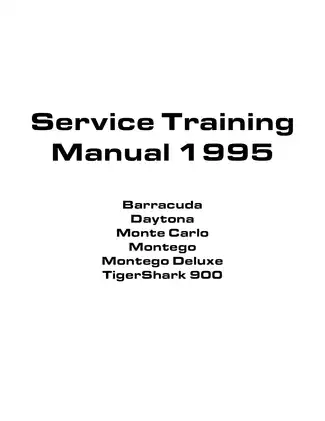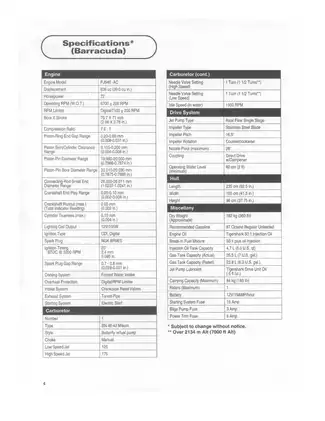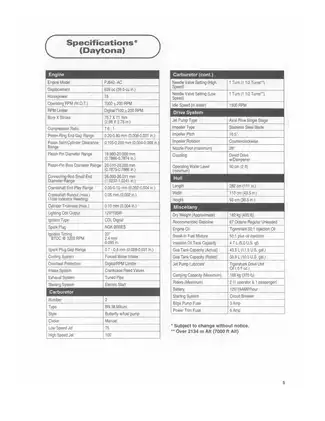Arctic Cat Tigershark Barracuda, Daytona, Monte Carlo, Montego & 900 PWC Service Training Manual, 1995 edition
Product Gallery

Sample pages from the Arctic Cat Tigershark Barracuda, Daytona, Monte Carlo, Montego & 900 PWC Service Training Manual, 1995 edition manual




Purchase Information
1995 Tigershark PWC Service Manual | Monte Carlo, Daytona, 900 - Technical Specifications
- Document Number / Seller:
- 29244 / Amanda Peterson
- File Size:
- 44.33 MB
- File Type:
- Language:
- English
- Pages:
- 229
- Printable:
- Yes
- Estimated Download Time:
- 0.91 Minutes
- Delivery Format:
- Digital (PDF) - Instant Access
- Category:
- Personal Watercraft (PWC)
- Brand:
- Arctic Cat
- Reviewed and Approved:
- Nov 30, 2025
Arctic Cat Models and Parts Covered in this Personal Watercraft (PWC) Manual
- Barracuda (1995)
- Daytona (1995)
- Monte Carlo (1995)
- Montego (1995)
- Montego Deluxe (1995)
- Tigershark 900 (1995)
Complete Manual Information
1995 Tigershark PWC Service Training Manual | Barracuda, Daytona, Monte Carlo, Montego & 900
Maintain your personal watercraft with the official factory-level insights used by certified technicians. This comprehensive 1995 Tigershark Service Training Manual is the definitive resource for owners and mechanics looking to perform everything from routine seasonal maintenance to complete engine overhauls.
Unlike generic aftermarket guides, this manual provides specific, in-depth technical data for the entire 1995 Arctco lineup. It is designed to be highly readable on mobile devices, allowing you to access torque specs and wiring diagrams directly at your workbench or out on the trailer.
Complete Model Coverage
This manual contains specific data and procedures for the following 1995 Tigershark models:
- Barracuda (1995)
- Daytona (1995)
- Monte Carlo (1995)
- Montego (1995)
- Montego Deluxe (1995)
- Tigershark 900 (1995)
Expert Maintenance & Repair Value
This manual is structured into dedicated sections to help you navigate complex repairs with confidence. It includes:
- Engine & Internal Components: Detailed instructions for the disassembly and inspection of cylinder heads, pistons, and crankshafts. Includes precise clearance specifications and wear limits essential for rebuilding high-performance 2-stroke engines.
- Fuel & Carburetion: Professional synchronization procedures for choke and throttle butterflies. Learn the exact "T" screw adjustments for perfect idle speeds (2500 rpm out of water / 1500 rpm in water) to ensure reliable starting and crisp throttle response.
- Jet Pump & Drive Systems: Step-by-step guidance on the impeller and pump assembly. Proper maintenance here is critical for maintaining maximum thrust and preventing cavitation.
- Electrical & Ignition: Comprehensive troubleshooting for the charging and ignition systems, featuring official wiring diagrams to eliminate guesswork when tracing electrical faults.
- Specialized Service Training: As a training manual, it goes beyond "how-to" by explaining the operation and construction of each system, helping you understand how your watercraft functions for more efficient troubleshooting.
Technical Specifications for DIY Success
Stop guessing at torque values or fluid capacities. This OEM-level guide provides the factory-spec technical information required to restore your Tigershark to its original operating condition. Whether you are winterizing a Montego or tuning a Tigershark 900 for the racing season, this manual ensures the job is done right the first time, saving you time and expensive labor costs.
Download Instructions for Arctic Cat Personal Watercraft (PWC) Manual
Frequently Asked Questions - Arctic Cat Personal Watercraft (PWC) Manual
What does this Arctic Cat manual cover?
This comprehensive service manual covers detailed repair procedures, maintenance schedules, troubleshooting guides, and technical specifications for Arctic Cat Tigershark Barracuda, Daytona, Monte Carlo, Montego & 900 PWC Service Training Manual, 1995 edition. It includes information for the following models: - Barracuda (1995) - Daytona (1995) - Monte Carlo (1995) - Montego (1995) - Montego Deluxe (1995) - Tigershark 900 (1995).
Is this manual suitable for beginners?
Yes, this Arctic Cat manual is designed for both professional technicians and DIY enthusiasts. It includes step-by-step procedures with clear illustrations and safety guidelines for Personal Watercraft (PWC) maintenance and repair.
What file format will I receive?
You will receive this manual as a PDF file (44.33 MB), which is compatible with all devices. The manual is fully searchable and printable for your convenience.
How quickly can I access the manual after purchase?
You'll receive instant access to your Arctic Cat Personal Watercraft (PWC) manual immediately after payment completion. The download link is valid for 3 days, with lifetime re-download guarantee.
Can I print specific sections of the manual?
Absolutely! This digital manual allows you to print any section you need, from individual pages to complete chapters, making it perfect for workshop use.
Customer Reviews and Feedback
Read what our customers say about this Arctic Cat Personal Watercraft (PWC) manual and share your own experience.
Add Comment
This policy contains information about your privacy. By posting, you are declaring that you understand this policy:
- Your name, rating, website address, town, country, state and comment will be publicly displayed if entered.
- Aside from the data entered into these form fields, other stored data about your comment will include:
- Your IP address (not displayed)
- The time/date of your submission (displayed)
- Your email address will not be shared. It is collected for only two reasons:
- Administrative purposes, should a need to contact you arise.
- To inform you of new comments, should you subscribe to receive notifications.
- A cookie may be set on your computer. This is used to remember your inputs. It will expire by itself.
This policy is subject to change at any time and without notice.
These terms and conditions contain rules about posting comments. By submitting a comment, you are declaring that you agree with these rules:
- Although the administrator will attempt to moderate comments, it is impossible for every comment to have been moderated at any given time.
- You acknowledge that all comments express the views and opinions of the original author and not those of the administrator.
- You agree not to post any material which is knowingly false, obscene, hateful, threatening, harassing or invasive of a person's privacy.
- The administrator has the right to edit, move or remove any comment for any reason and without notice.
Failure to comply with these rules may result in being banned from submitting further comments.
These terms and conditions are subject to change at any time and without notice.
Comments (3)